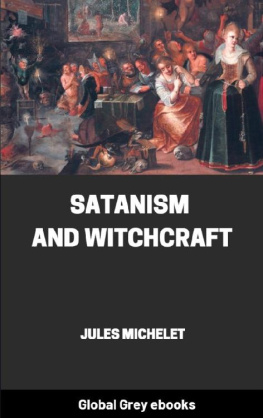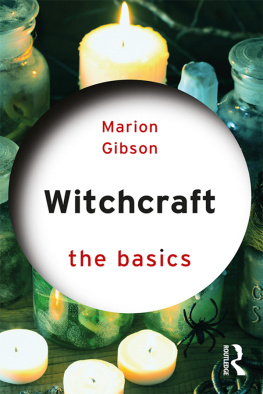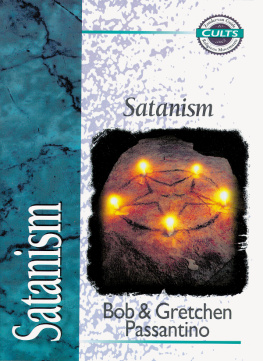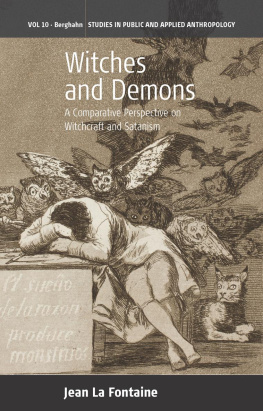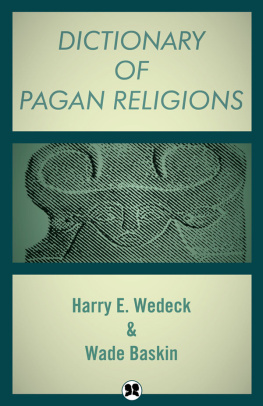Jules Michelet - Satanism and Witchcraft
Here you can read online Jules Michelet - Satanism and Witchcraft full text of the book (entire story) in english for free. Download pdf and epub, get meaning, cover and reviews about this ebook. year: 2017, publisher: CreateSpace Independent Publishing Platform, genre: Religion. Description of the work, (preface) as well as reviews are available. Best literature library LitArk.com created for fans of good reading and offers a wide selection of genres:
Romance novel
Science fiction
Adventure
Detective
Science
History
Home and family
Prose
Art
Politics
Computer
Non-fiction
Religion
Business
Children
Humor
Choose a favorite category and find really read worthwhile books. Enjoy immersion in the world of imagination, feel the emotions of the characters or learn something new for yourself, make an fascinating discovery.
- Book:Satanism and Witchcraft
- Author:
- Publisher:CreateSpace Independent Publishing Platform
- Genre:
- Year:2017
- Rating:3 / 5
- Favourites:Add to favourites
- Your mark:
- 60
- 1
- 2
- 3
- 4
- 5
Satanism and Witchcraft: summary, description and annotation
We offer to read an annotation, description, summary or preface (depends on what the author of the book "Satanism and Witchcraft" wrote himself). If you haven't found the necessary information about the book — write in the comments, we will try to find it.
Satanism and Witchcraft — read online for free the complete book (whole text) full work
Below is the text of the book, divided by pages. System saving the place of the last page read, allows you to conveniently read the book "Satanism and Witchcraft" online for free, without having to search again every time where you left off. Put a bookmark, and you can go to the page where you finished reading at any time.
Font size:
Interval:
Bookmark:
SATANISM
AND WITCHCRAFT
BY
JULES MICHELET
AS TRANSLATED BY ALFRED RICHARD ALLINSON FROM THE FRENCH
(ORIGINAL TITLE "LA SORCIRE," PARIS: E. DENTU [1862])
1939
Satanism And Witchcraft By Jules Michelet.
This edition was created and published by Global Grey
GlobalGrey 2019
Get more free ebooks at

globalgreyebooks.com
SPRENGER said, before 1500: "We should speak of the Heresy of the Sorceresses, not of the Sorcerers; the latter are of small account." So another writer under Louis XIII.: "For one Sorcerer, ten thousand Sorceresses."
"Nature makes them Sorceresses,"the genius peculiar to woman and her temperament. She is born a creature of Enchantment. In virtue of regularly recurring periods of exaltation, she is a Sibyl; in virtue of love, a Magician. By the fineness of her intuitions, the cunning of her wilesoften fantastic, often beneficentshe is a Witch, and casts spells, at least and lowest lulls pain to sleep and softens the blow of calamity.
All primitive peoples start alike; this we see again and again in the accounts given by travellers. Man hunts and fights. Woman contrives and dreams; she is the mother of fancy, of the gods. She possesses glimpses of the second sight, and has wings to soar into the infinitude of longing and imagination. The better to count the seasons, she scans the sky. But earth has her heart as well. Her eyes stoop to the amorous flowers; a flower herself in her young beauty, she learns to know them as playfellows and intimates. A woman, she asks them to heal the men she loves.
Pathetic in their simplicity these first beginnings of Religion and Science! Later on, each province will be separated, we shall see mankind specialiseas medicine-man, astrologer or prophet, necromancer, priest, physician. But in these earliest days woman is all in all, and plays every part.
A strong and bright and vigorous religion, such as was Greek Paganism, begins with the Sibyl, to end with the Sorceress. The first, a virgin fair and beautiful, brilliant in the full blaze of dawn, cradled it, gave it its charm and glamour. In later days, when sick and fallen, in the gloom of the Dark Ages, on heaths and in forests, it was concealed and protected by the Sorceress; her dauntless pity fed its needs and kept it still alive. Thus for religions it is woman is mother, tender protectress and faithful nurse. Gods are like men; they are born and they die on a woman's breast.
But what a price she paid for her fidelity!... Magian queens of Persia, enchanting Circ, sublime Sibyl, alas! how are you fallen, how barbarous the transformation you have suffered!... She who, from the throne of the Orient, taught mankind the virtues of plants and the motions of the stars, she who, seated on the Delphic tripod and, illumined by the very god of light, gave oracles to a kneeling world, is the same that, a thousand years later, is hunted like a wild beast, chased from street to street, reviled, buffeted, stoned, scorched with red-hot embers!...
The clergy has not stakes enough, the people insults, the child stones, for the unhappy being. The poet, no less a child, throws yet another stone at her, a crueller one still for a woman. Gratuitously insulting, he makes her out always old and ugly. The very word Sorceress or Witch calls up the image of the Weird Sisters of Macbeth. Yet the cruel witch trials prove exactly the opposite; many perished just because they were young and pretty.
The Sibyl foretold the future; but the Sorceress makes it. Here is the great, the vital distinction. She evokes, conjures, guides Destiny. She is not like Cassandra of old, who foresaw the coming doom so clearly, and deplored it and awaited its approach; she creates the future. Greater than Circ, greater than Medea, she holds in her hand the magic wand of natural miracle, she has Nature to aid and abet her like a sister. Foreshadowings of the modern Prometheus are to be seen in her,a beginning of industry, above all of the sovereign industry that heals and revivifies men. Unlike the Sibyl, who seemed ever gazing towards the dayspring, she fixes her eyes on the setting sun; but it is just this sombre orb of the declining luminary that shows long before the dawn (like the glow on the peaks of the High Alps) a dawn anticipatory of the true day.
The Priest realises clearly where the danger lies, that an enemy, a menacing rival, is to be feared in this High-priestess of Nature he pretends to despise. Of the old gods she has invented new ones. Beside the old Satan of the past, a new Satan is seen burgeoning in her, a Satan of the future.
For a thousand years the people had one healer and one only,the Sorceress. Emperors and kings and popes, and the richest barons, had sundry Doctors of Salerno, or Moorish and Jewish physicians; but the main body of every State, the whole world we may say, consulted no one but the Saga, the Wise Woman. If her cure failed, they abused her and called her a Witch. But more generally, through a combination of respect and terror, she was spoken of as the Good Lady, or Beautiful Lady (Bella Donna), the same name as that given to fairies.
Her fate resembled that which still often befalls her favourite herb, the belladonna, and other beneficent poisons she made use of, and which were antidotes of the great scourges of the Middle Ages. Children and ignorant passers-by cursed these sombre flowers, without understanding their virtues, scared by their suspicious colour. They shudder and fly the spot; yet these are the Comforting plants (Solanace), which, wisely administered, have worked so many cures and soothed so much human agony.
They are found growing in the most sinister localities, in lonely, ill-reputed spots, amid ruins and rubbish heaps,yet another resemblance with the Sorceress who utilises them. Where, indeed, could she have taken up her habitation, except on savage heaths, this child of calamity, so fiercely persecuted, so bitterly cursed and proscribed? She gathered poisons to heal and save; she was the Devil's bride, the mistress of the Incarnate Evil One, yet how much good she effected, if we are to credit the great physician of the Renaissance! Paracelsus, when in 1527, at Ble, he burned the whole pharmacopia of his day, declared he had learned from the Sorceresses all he knew.
Had they not earned some reward? Yes! and reward they had. Their recompense was torture and the stake. New punishments were devised for their especial benefit, new torments invented. They were brought to trial en masse, condemned on the slightest pretext. Never was such lavish waste of human life. To say nothing of Spain, the classic land of the auto-da-f, where Moor and Jew are always associated with Witches, seven thousand were burned at Trves, and I know not how many at Toulouse; at Geneva five hundred in three months (1513); eight hundred at Wurzburg, in one batch almost, and fifteen hundred at Bamberg,both of these quite small bishoprics! Ferdinand II. himself, the bigot, the cruel Emperor of the Thirty Years War, was forced to restrain these worthy bishops, else they would have burned all their subjects. I find, in the Wurzburg list, a wizard of eleven, a schoolboy, and a witch of fifteen, at Bayonne, two sorceresses of seventeen, damnably pretty.
Mark this, at certain epochs the mere word of Sorceress or Witch is an arm wherewith Hate can kill at discretion. Female jealousy, masculine avarice, are only too ready to grasp so convenient a weapon. Such and such a neighbour is rich?... Witch! witch! Such and such is pretty?...
Next pageFont size:
Interval:
Bookmark:
Similar books «Satanism and Witchcraft»
Look at similar books to Satanism and Witchcraft. We have selected literature similar in name and meaning in the hope of providing readers with more options to find new, interesting, not yet read works.
Discussion, reviews of the book Satanism and Witchcraft and just readers' own opinions. Leave your comments, write what you think about the work, its meaning or the main characters. Specify what exactly you liked and what you didn't like, and why you think so.

